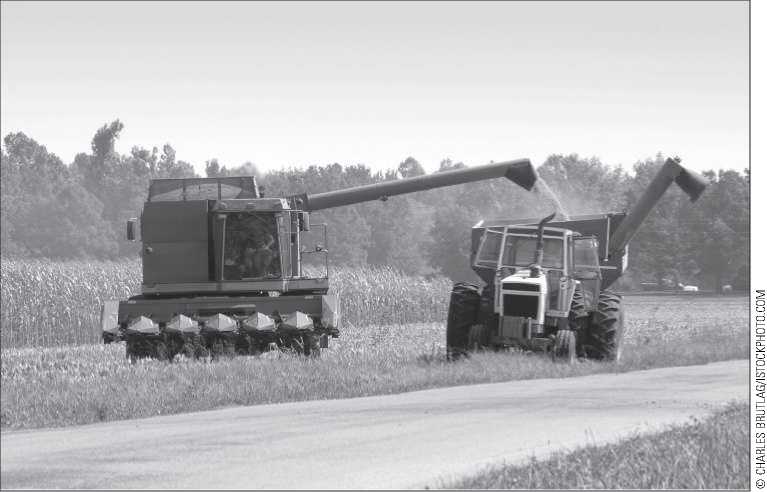A decline in the number of agricultural workers relative to the total workforce is a common feature of economic development. It is estimated that in 1800 about three-fourths of the American workforce was employed in agriculture. By 1850, that proportion had fallen to 55 percent. By 1950, it had fallen to 8.8 percent. And by 2009 (the most recent figure), only about 1.1 percent of the American labor force worked on the farm. Similar declines were recorded throughout the industrial world. In Italy, for example, agricultural employment, measured as a share of the total labor force, fell from more than 30 percent in 1960 to about 5.3 percent in 2010; in Japan, the change was similar, a fall from just less than 30 percent in 1960 to about 4.8 percent in 2010.
The decline in the agriculture’s share of the workforce was the result of two phenomena. First, the demand for agricultural products grew more slowly than real income. The income elasticity of demand for agricultural products, to use the technical term (the percentage change in the demand for an agricultural product produced by a given percentage change in real income), is typically less than one. Second, rapid technological progress in agriculture reduced the number of workers it took to produce a given amount of agricultural product. Technological progress in turn resulted from several factors. Farm machinery evolved rapidly. Tractors became larger, and sensitive electronic equipment was added that could monitor plowing, seeding, and harvesting. New herbicides and pesticides were developed, and scientific breeding of plants and animals and genetic modification further expanded output. In some cases, these developments were linked. Chemicals were used to defoliate cotton plants to make mechanical harvesting easier, and new strains of tomatoes were developed with tough skins that could withstand mechanical harvesting and cross-country—and eventually international-transport. These innovations came from private companies producing farm machinery, chemicals, and seeds, and from federal and state laboratories and experiment stations. So successful were federal and state agencies in finding ways to increase output that liberals used the agricultural sector as an example of how the federal government could produce important technological advances with commercial applications.
The number of farms, as well as the number of farm workers declined for much of the postwar period. This is shown in Table 27.2, which includes some earlier years for comparison. In 1950, there were 5.39 million farms in the United States; by 1990, that number had fallen to 2.14 million, fewer than in 1870. The amount of land in farms

Large farms with heavy investments in modern technology increasingly dominated the farm sector. Compare the grain harvester shown here with the reaper shown in Chapter 15.
TABLE 27.2 CHANGING STRUCTURE OF U. S. AGRICULTURE ]
|
TOTAL LAND IN FARMS | |||
|
YEAR |
FARMS (in thousands) |
MILLIONS OF ACRES |
AVERAGE FARM SIZE IN ACRES |
|
1850 |
1,449 |
294 |
203 |
|
1870 |
2,660 |
408 |
153 |
|
1880 |
4,009 |
536 |
134 |
|
1900 |
5,740 |
841 |
147 |
|
1920 |
6,454 |
959 |
149 |
|
1940 |
6,109 |
1,065 |
175 |
|
1950 |
5,388 |
1,161 |
216 |
|
1960 |
3,962 |
1,177 |
297 |
|
1970 |
2,954 |
1,108 |
373 |
|
1980 |
2,440 |
1,039 |
426 |
|
1990 |
2,140 |
987 |
461 |
|
2000 |
2,172 |
943 |
434 |
|
2010 |
2,201 |
920 |
418 |
Note: The definition of a farm changed in 1993 to include some smaller farm operations, so later figures are not strictly comparable to earlier figures. Source: 1850-1990: Historical Statistics, 2006 table Dal4-27; 2000-2007: Statistical Abstract of the United States 2012..
Also fell, but at a slower rate, from 1.16 billion acres in 1950 to 920 million in 2010. The result was that average farm size, shown in the final column of Table 27.2, rose over the long term from 216 acres per farm in 1950 to 461 acres in 1990. It was the farmer working a small - or medium-sized farm who gave up the business. Much of the land went into larger farms owned by individual owner-operators or corporations. Indeed, the rise of corporate farm ownership was a striking and controversial feature of the postwar period, although many corporate farms were simply family farms converted to corporate status for tax purposes. “Factory farming,” in which poultry and livestock were produced in factory-like conditions, became a frequent target of critics who charged that farm animals were kept under inhumane conditions, that factory farming increased the danger from Salmonella and other food-borne diseases, and that pollution from factory farming endangered the environment.
In recent years, there has been a modest reversal in the long-term trends in the number and size of farms. The number of farms in the United States increased from 2.14 million in 1990 to 2.20 million in 2010, and the average farm size declined from 461 acres in 1990 to 418 acres in 2010. The economic and ethnic diversity of farm ownership, moreover, also increased modestly in recent years. Although the average size of farms declined, most of the change came from the addition of small farms; many factory farms continued to expand.
What had provoked these changes? The operators of small - and medium-sized farms were both pushed and pulled from the farm. Typically, only those farm operators who could farm on a large scale and achieve the high productivity possible through massive investments in farm equipment could make farming pay. Alan Olmstead and Paul Rhode (2001) estimated that the tractor alone accounted for the disappearance of 956,000 farms between 1910 and 1960. In the cotton-growing South, for example, many landholders terminated small tenancies and consolidated their land so that they could make use of large-scale machinery. People were also pulled from agriculture by the possibility of earning higher incomes elsewhere. Tenant farmers in the South, for example, moved to industrial centers in the Mississippi Valley, the Midwest, and the Pacific Coast. While leaving farming generally meant earning more money, it was not a decision taken lightly, for it meant leaving family and friends behind and giving up a cherished way of life.
Why did farmers continue to leave the land, despite substantial efforts by the federal government to aid them? Partly, this was because the lion’s share of assistance went to those who were already at the top of the heap. When the government supported farm prices, those with the most bushels or bales to sell received the chief benefits; when acreage restrictions were put into effect, those who were in a position to reduce acreage the most received the largest checks. In 1989, for example, the top 15 percent of farm families by income received 62 percent of all government payments.




 World History
World History









